Attack on Richard Nixon's motorcade
An attack on Richard Nixon's motorcade occurred in Caracas, Venezuela, during his 1958 goodwill tour of South America, undertaken while Nixon was Vice President of the United States. The attack on Nixon's car was called, at the time, the "most violent attack ever perpetrated on a high American official while on foreign soil". Close to being killed while a couple of his aides were injured in the melee, Nixon ended up unharmed and his entourage managed to reach the U.S. embassy. The visit took place only months after the overthrow of Venezuelan dictator Marcos Pérez Jiménez, who was awarded the Legion of Merit and later granted asylum by the United States, and the incident may have been orchestrated by the Communist Party of Venezuela. U.S. Navy Admiral Arleigh Burke mobilized fleet and Marine units to the region, compelling the Venezuelan government to provide full protection to Nixon for the remainder of the trip.
| Attack on Richard Nixon's Motorcade | ||||
|---|---|---|---|---|
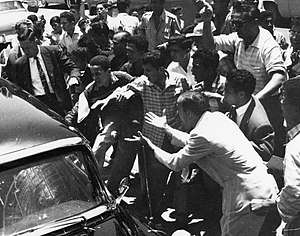 Nixon's car attacked in Caracas | ||||
| Date | May 13, 1958 | |||
| Location | 10°28′50″N 66°54′13″W | |||
| Caused by |
| |||
| Resulted in |
| |||
| Parties to the civil conflict | ||||
| ||||
| Lead figures | ||||
| ||||
| Units involved | ||||
| ||||
| Number | ||||
| ||||
.svg.png) Location within Venezuela | ||||
The attack was denounced by all major Venezuelan presidential candidates standing in that year's election, except for the incumbent leader Admiral Wolfgang Larrazábal. Nixon was generally applauded in American press reports for his calm and adept handling of the incident and was feted with a "hero's welcome" on his return to the United States. His recollections of the attack form one of the "six crises" explored in his Six Crises book.
Context
Richard Nixon's carefully planned 1958 tour of South America has been described as one of the "most important United States foreign policy events in post-WWII Latin America".[2] It was undertaken at a time of confused United States intra-hemispheric relations; the role of Latin American states in the emerging American grand strategy of containment was unclear and ill-defined. However, a recent worldwide drop in commodity prices that badly affected South American economies, coupled with increasing Soviet overtures in the western hemisphere, made President of the United States Dwight Eisenhower determine that a tour by a major United States functionary was necessary to demonstrate U.S. commitment to the region.[2] Nixon retrospectively wrote that he was uninterested in taking the trip.[3]
The tour was to see Nixon visit every independent country in South America except Brazil and Chile.[lower-alpha 1] Brazil had been omitted from the itinerary as Nixon had visited that nation the previous year. The Chilean leadership, meanwhile, were scheduled to be out-of-the-country during the time period of Nixon's visit. Nixon was accompanied on his trip by his wife, Pat Nixon.[3]
Early tour stops

Nixon began his tour in Uruguay, arriving at Carrasco International Airport at 9:00 a.m. on April 28. There, he was greeted by senior Uruguayan officials.[4] According to an Associated Press report at the time, about 40 students protested on the street corner as Nixon's motorcade proceeded into Montevideo.[5] In Montevideo, Nixon made an unscheduled appearance at the University of the Republic and was generally well-received by students. According to Nixon, he decided to make the unannounced stop because he felt that average Uruguayans would be receptive towards him, while scheduled and published visits were likely to attract organized demonstrations. This proved to be the case, and when communists arrived and tried to distribute literature, the students tore up the pamphlets.[3]
The visit to Argentina was billed as the major stop of the trip and four days were allotted to the country, instead of the two slated for the other visits. In Buenos Aires, Nixon attended the presidential inauguration of Arturo Frondizi and spoke to several student and organized labor groups.[6]
The first serious trouble on the tour materialized in Lima, Peru. Nixon's scheduled appearance at the University of San Marcos saw a large crowd of student demonstrators awaiting his arrival. In an event foreshadowing his famous visit to the Lincoln Memorial to meet anti-war protesters some years later, Nixon waded directly into the crowd of demonstrators, attended by only two staff members. Over the next few minutes Nixon spoke with the students, however, a second faction of demonstrators soon began stoning the group, hitting one of Nixon's staff in the mouth and grazing the vice-president's neck. The vice-president then withdrew and a later round-table with student leaders was canceled. Returning to his hotel, Nixon and his staff had to push through demonstrators who had encamped outside, during which Nixon was struck in the face.[7][8][2] Eisenhower cabled Nixon at his next stop, in Quito, Ecuador:[9]
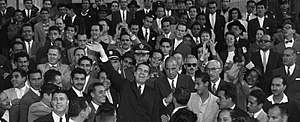
Dear Dick: Your courage, patience and calmness in the demonstration directed against you by radical agitators have brought you new respect and admiration in our country. I am certain that the vast majorities of citizens both in Peru and in the United States deplore the incident caused by a few. I note with satisfaction that the Peruvian Government has already expressed to you its regret. Indeed, I feel that every participant in the mob will finally come to feel a sense of guilt and embarrassment because of his failure to show toward a friendly visitor the ordinary measure of courtesy and hospitality. Give my love to Pat and warm regards to yourself.
Nixon's final stop before Venezuela and Colombia saw generally receptive crowds. At Bolívar Square in Bogotá, he laid a wreath at the statue of Simón Bolívar before a crowd of about 1,000. An Associated Press report noted that there were some hecklers in the audience, but they amounted to "about 80 youths" and observed that "generally ... the Colombian crowds were friendly or enthusiastic".[2][10]
Tour in Venezuela
Background
Earlier in 1958, the disliked Venezuelan dictator Marcos Pérez Jiménez had been overthrown in a popular uprising and had gone into exile in the United States. A military junta formed a caretaker government to rule the country until new elections could be held. Admiral Wolfgang Larrazábal, head of the governing junta, had announced his intention to stand in those elections; his candidacy was backed by a coalition of parties, including the Venezuelan Communist Party. The United States' decision to grant Pérez Jiménez asylum and to award him the Legion of Merit on 12 November 1954[11][12] combined to create a charged atmosphere leading up to Nixon's arrival. The Caracas municipal council even passed a resolution effectively declaring Nixon persona non grata.[13] Prior to Nixon's arrival in Caracas, media reported on rumors that an attempt had been planned on the vice-president's life during his visit.[14] The CIA station chief in Venezuela, meanwhile, urged that this leg of the trip be canceled.[13]
In an interview conducted after he retired from government service, Robert Amerson, then-press attache to the United States embassy in Venezuela, claims that the demonstrators who disrupted the Venezuela stop on the tour "had been bused down by the professional agitators and organizers" affiliated with the Communist Party of Venezuela.[lower-alpha 2][16] This view was one echoed in a report issued by William P. Snow, acting Assistant Secretary of State for Inter-American Affairs, who wrote that "the pattern of organization and of slogans in all cases points to Communist inspiration and direction, as do certain of the intelligence reports".[2] Nixon, himself, also blamed Communist instigation.[3] A Universal Newsreel at the time characterized it as "another of the well-planned campaigns of harassment" and a "communist-sparked onslaught".[17] Venezuelan journalist Carlos Rangel has indicated the "Nixon carnival" was organized by the Venezuelan Communist Party as a way of demonstrating that it had the ability to "dominate the streets, that the Caracas masses were ready to be mobilized".[18]
Arrival
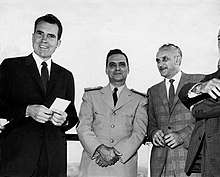
Nixon arrived, via air, in Caracas on May 13, 1958. According to a U.S. Secret Service report of the incident, a crowd of demonstrators at the airport "purposely disrupted ... [the] welcoming ceremony by shouting, blowing whistles, waving derogatory placards, throwing stones, and showering the Nixons with human spittle and chewing tobacco".[19] Reporting for the New York Herald Tribune, Earl Mazo wrote that "Venezuelan troops and police seemed to evaporate. The vice-president and the whole official party literally had to fight their way to cars behind a thin but sturdy phalanx of U.S. Secret Service agents".[1]

The original itinerary had Nixon moving from the airport to the National Pantheon of Venezuela where he was to lay a wreath at the tomb of Simón Bolívar. However, a United States naval attache sent ahead with the wreath reported a crowd that had assembled at the Pantheon had attacked him and torn up the wreath. At this point it was decided to proceed directly to the U.S. embassy.[16]
Attack
For the first time on the South America tour, the Nixons traveled in closed-top cars, as opposed to convertibles, a decision later credited with saving their lives.[17]
As the Nixons traveled by motorcade through Caracas, the vehicle carrying the Vice-President was slowed to a crawl by heavy traffic.[lower-alpha 3] A crowd used the stoppage to throng Nixon's vehicle, stoning it and banging the windows with their fists.[19] Nixon was protected by twelve United States Secret Service agents, some of whom were injured in the melee.[21] According to the Secret Service, Venezuelan police declined to intervene to clear the crowd. When the mob began rocking the car back and forth in an attempt to overturn it, U.S. Secret Service agents, believing the vice-president's life was in jeopardy, drew their firearms and prepared to begin shooting into the crowd. In an act described as "the kind of presence of mind for which battlefield commanders win medals", Nixon ordered Secret Service agent-in-charge Jack Sherwood to hold fire and shoot only on his orders; no shots were ultimately fired.[7][19][22]
Nixon would later recount that Venezuelan Foreign Minister Óscar García Velutini, who was traveling with him, was "close to hysterics" and kept repeating "this is terrible, this is terrible". According to Nixon, Velutini explained the police inaction was because the communists "helped us overthrow Pérez Jiménez and we are trying to find a way to work with them".[3] Nixon's longtime secretary, Rose Mary Woods, was injured by flying glass when the windows of the car in which she was riding, following Nixon, were smashed. Vernon Walters, then a mid-ranking U.S. Army officer serving as Nixon's translator, would end up with a "mouthful of glass",[22] and Velutini was also hit by shards of the limousine's supposedly "shatter-proof" glass.[7]
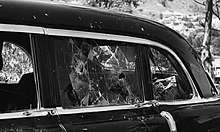
Two different accounts explain how Nixon's car was ultimately able to escape the mob and continue to the embassy. According to one version of events, the U.S. press corps' flatbed truck, accompanying the motorcade, was used to clear a path through the crowd.[19] In Nixon's remembrance of the incident, Associated Press photographer Hank Griffin at one point had to use his camera to beat back a protester who tried to mount the truck.[3] According to a second account, soldiers of the Venezuelan Army arrived and cleared the traffic, thereafter moving the mob back at bayonet-point to allow Nixon's car to pass.[23]
Embassy
Shortly after the Nixons arrived at the embassy, the Venezuelan army surrounded and fortified the chancellery, reinforcing the small U.S. Marine guard force. Their assistance had earlier been requested by the U.S. ambassador.[13] That afternoon, members of the ruling junta arrived at the embassy and lunched with Nixon. The next morning, representatives of Venezuela's major labor unions came to the embassy and requested an audience with Nixon, which was granted. The union leaders apologized for events of the preceding day and disclaimed involvement, though, United States Air Force officer Manuel Chavez[lower-alpha 4] – at the time attached to the embassy – wrote in 2015 that "they probably were the instigators or at least encouraged the actions".[13]
U.S. mobilization
Upon learning of the incident, Chief of Naval Operations Admiral Arleigh Burke ordered the airlift of elements of the 2nd Marine Division and the 101st Airborne Division to staging areas in Puerto Rico and Guantánamo Bay, Cuba. The aircraft carrier USS Tarawa, along with eight destroyers and two amphibious assault ships, were ordered to put to sea towards Venezuela.[21][24] The U.S. mobilization was code-named "Operation Poor Richard".[7]
_underway_at_sea_on_18_December_1952.jpg)
According to U.S. officials at the time, the forces mobilized were being readied to enter Venezuela to "cooperate with the Venezuelan government", though later accounts suggest President Eisenhower was preparing to "invade Venezuela" should Nixon suffer further indignity.[18][21][24] Privately, Eisenhower was reportedly furious at the attack on Nixon and, at one point, told his staff "I am about ready to go put my uniform on".[25][26]
Nixon was shocked after learning about the mobilization and wondered why they were not consulted, but later found out that communications between Caracas and Washington had been cut for a critical period immediately after the riot that afternoon.[3]
In response to the movement of American military forces into the region, Admiral Larrazábal pledged the Nixon party would be "protected fully" thereafter.[27]
Return to the United States
Additional activities were canceled, and Nixon departed Caracas the next morning, seven hours early. His motorcade to the airport was protected by a major deployment of Venezuelan Army infantry and armored forces in the capital.[17][13] Nixon described having taken the same route as before, whose streets were empty and heavily patrolled after the whole area had been tear-gassed.[3]
American reaction
Eisenhower ordered that Nixon should receive a "hero's welcome" on his return; all U.S. government employees in Washington, D.C. were given the day off work to turn-out for the arrival of the vice-president. Nixon deplaned before "a cheering crowd of 10,000" that included the congressional leadership and ambassadors from most Latin American countries. Eisenhower personally greeted Nixon at the airport and the two then traveled to the White House along a route lined by 100,000 people.[17][28][29]
Life credited Nixon for his "courage" and said "his coolness had been remarkable".[30] According to Pathé News, Nixon reflected "calm, rather than concern."[31] For weeks after the attack, Nixon received standing ovations "wherever he went ... a new high in his life".[7] By contrast, The New Republic claimed the attack was a hoax set up to help Nixon's chances in the 1960 U.S. presidential election.[7]
All twelve agents of Nixon's Secret Service detail received the Decoration for Exceptional Civilian Service from Eisenhower at Nixon's request.[3]
Venezuelan reaction
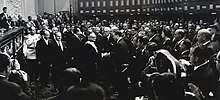
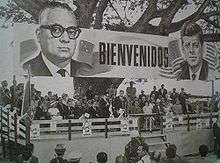
In Venezuela, all major presidential candidates standing in the 1958 general election denounced the attack except for the incumbent president, Admiral Larrazábal. After Nixon's departure, Larrazábal said that he would have joined the protests if he were a student. Although receiving strong backing by the communists, Larrazábal lost the election to Rómulo Betancourt.[32]
During the 1961 visit of U.S. President John F. Kennedy to Venezuela, anti-American violence also broke out, however, a repeat of the 1958 attack was avoided. President Betancourt pre-deployed significant Venezuelan military forces into Caracas in advance of Kennedy's arrival and ordered the preventive arrest of suspected ringleaders. All ten miles of the highway Kennedy was scheduled to travel from the airport, the same highway traveled by Nixon, were closed effective the day before Kennedy's arrival.[33]
A 2013 editorial on the attack published by the Bolivarian radio station Alba Ciudad disputed the characterization of the incident, explaining that, "no one forced him [Nixon] to stay on Venezuelan soil, no one had him abducted, no one was blocking him or holding him in the country. To the contrary, people asked him to leave!"[26]
Significance
Pathé News, at the time, described the assault as "the most violent attack ever perpetrated on a high American official while on foreign soil".[31]
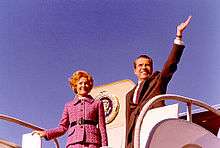
Various sources describe the attack as one that nearly led to Nixon's death[2] and, though it is generally agreed he acted with remarkable composure throughout, the incident had a lasting impact on him.[34] In his first book, Six Crises, Nixon wrote of the experience as one of the titular crises with great impact on his life.[35]
Every year on the anniversary of the attack, Nixon would "privately celebrate" with Vernon Walters.[34] Nixon would favor Walters for the rest of his career, eventually appointing him Deputy Director of Central Intelligence.[34] On the eve of Walters' retirement from government service, in 1991, Nixon explained his longtime patronage of the general, writing him that "you and I have faced death together and that gives us a special bond".[36]
The hardening of Nixon's attitude toward Latin America, which he came to "equate with violence and irrationality", has been attributed to his experience of the attack. Some believe this change of mood foreshadowed his subsequent support for covert U.S. actions directed in support of dictatorial regimes in the region. In fact, he would later privately list several nations whose populations, he believed, were too immature for democratic government and would be better administered by authoritarian regimes, specifically citing France, Italy, and all of Latin America "except for Colombia".[37][25]
The incident has been credited with first making American policymakers aware of growing popular resentment to U.S. policies in Latin America.[38] By the end of 1958, the U.S. National Security Council would list "yankeephobia" as a key challenge to U.S. interests in Latin America.[25]
See also
- Eva Perón's "Rainbow Tour"
- History of Venezuela (1948–58)
- Operation Condor
Notes
- Suriname and Guyana were not, at the time, independent.
- Amerson would later write a letter to The New York Times in which he questioned if "Caracas dramatized to him that since local conditions primarily caused anti-American sentiment, international Communism might not really be monolithic. This may have influenced his Presidential decisions to deal directly with Communist leaders in China and the Soviet Union."[15]
- According to Drew Pearson, citing secondhand information, Nixon had personally insisted the press truck drive ahead of his vehicle. The larger vehicle could only make 25 miles per hour which slowed the entire motorcade to the point the mob was able to stop it.[20]
- Chavez was a relative of Senator Dennis Chávez.[13]
References
- Mazo, Earl (May 14, 1958). "Screeching Mob Hurls Rocks at Nixon". San Bernardino County Sun. Archived from the original on March 17, 2017. Retrieved March 16, 2017 – via Newspapers.com.
- Cox, Jeff. ""They Aren't Friendly, Mr. Vice President"". American Diplomacy. University of North Carolina. ISSN 1094-8120. Retrieved March 13, 2017.
- Nixon, Richard (1962). Six Crises. Doubleday. pp. 183–284.
- "Nixon Begins Goodwill Tour". The Daily Inter-Lake. United Press International. April 28, 1958. Archived from the original on March 15, 2017. Retrieved March 14, 2017 – via Newspapers.com.
- "Cheers and Jeers Get Nixon's Smile". Terre Haute Star. Associated Press. April 29, 1958. Archived from the original on March 15, 2017. Retrieved March 14, 2017 – via Newspapers.com.
- Diaz-Bonilla, Eugenio (2011). A Long and Winding Road: The Creation of the Inter American Development Bank. pp. 65–66. ISBN 1257089994.
- Perlstein, Rick (2010). Nixonland: The Rise of a President and the Fracturing of America. Simon and Schuster. pp. 48–49. ISBN 1451606265.
- "Peru Apologizes for Violence on Nixon". Delta Democrat-Gazette. United Press International. May 9, 1958. Retrieved March 15, 2017 – via Newspapers.com.
- "Message From the President to the Vice President, at Quito". Office of the Historian. U.S. Department of State. Retrieved March 15, 2017.
- Bradshaw, Stanford (May 12, 1958). "Nixon Shrugs Off Hecklers". Monroe News-Star. Associated Press. Archived from the original on March 16, 2017. Retrieved March 15, 2017 – via Newspapers.com.
- Office of the Historian, ed. (January 19, 1955). "Progress Report by the Operations Coordinating Board to the National Security Council". FRUS. Archived from the original on January 6, 2019. Retrieved January 6, 2019.
- "Marcos Perez Jimenez – Legion of Merit". valor.militarytimes.com. Archived from the original on 2018-02-15. Retrieved 2019-01-06.
- Chavez, Manny (May 3, 2015). "Just Why Did Nixon Go to Venezuela in 1958 Anyway?". History News Network. Archived from the original on March 15, 2017. Retrieved March 14, 2017.
- "Warn Guards of Nixon Plot Tip". Chicago Tribune. May 13, 1958. Retrieved February 26, 2020 – via Newspapers.com.
- Amerson, Robert (May 8, 1994). "Even Now, Nixon Stirs Up Friend and Foe Alike; Tempered by Caracas". The New York Times. Archived from the original on March 16, 2017. Retrieved March 15, 2017.
- "The Day Venezuelans Attacked Nixon". Foreign Affairs Oral History Project. Association for Diplomatic Studies and Training. Archived from the original on December 17, 2016. Retrieved March 13, 2017.
- "Nixon Ordeal". Universal Newsreel. Associated Press. May 1958. Archived from the original on April 6, 2017. Retrieved March 14, 2017.
- Rangel, Carlos (1977). The Latin Americans. Transaction. p. 124. ISBN 141283757X.
- Glass, Andrew (May 13, 2014). "Vice President Nixon's motorcade attacked in Venezuela, May 13, 1958". Politico. Archived from the original on March 14, 2017. Retrieved March 13, 2017.
- Pearson, Drew (2015). Washington Merry-Go-Round: The Drew Pearson Diaries, 1960–1969. U of Nebraska Press. p. 62. ISBN 1612347134.
- "Nixon attacked by angry Venezuelans". History. History Channel. Retrieved February 26, 2020.
- Aitken, Jonathan (2015). Nixon: A Life. Regnery Publishing. pp. 296–297. ISBN 1621574423.
- Summers, Anthony (2001). The Arrogance of Power: The Secret World of Richard Nixon. Penguin. ISBN 1101199482.
- "Troops Fly to Aid Nixon". Press-Courier. United Press International. May 14, 1958. Archived from the original on March 14, 2017. Retrieved March 13, 2017 – via Newspapers.com.
- Friedman, Max (2012). Rethinking Anti-Americanism. Cambridge University Press. pp. 156–159. ISBN 0521683424.
- "Venezuela casi fue invadida en 1958 cuando ocurrió un hecho similar al vivido por Evo Morales". Alba Ciudad. July 10, 2013. Retrieved March 15, 2017.
- "Troops Arrive to Help Nixon". Ironwood Daily Globe. Associated Press. May 13, 1958. Retrieved March 14, 2017 – via Newspapers.com.
- Lungren, John. Healing Richard Nixon: A Doctor's Memoir. University Press of Kentucky. p. 185. ISBN 0813129095.
- "Big Nixon Welcome Today". Chicago Tribune. May 15, 1958. Retrieved February 26, 2020 – via Newspapers.com.
- "Caracas: The U.S. Reaction". LIFE. May 26, 1958.
- "Tragic Incidents In Venezuela Against Vice President Nixon (1958)". British Pathé. Pathé News. Archived from the original on April 6, 2017. Retrieved March 16, 2017.
- Drinot, Paulo (2010). Che’s Travels: The Making of a Revolutionary in 1950s Latin America. Duke University Press. pp. 166–167. ISBN 0-8223-9180-5. Archived from the original on 2017-03-31. Retrieved 2017-03-30.
- Ewell, Judith (1996). Venezuela and the United States: From Monroe's Hemisphere to Petroleum's Empire. University of Georgia Press. pp. 214–215. ISBN 978-0-8203-1782-3. Archived from the original on 2017-03-31. Retrieved 2017-03-30.
- "Vernon Walters, Back in His World". The Washington Post. December 16, 1985. Archived from the original on April 4, 2017. Retrieved March 15, 2017.
- Nixon, Richard (1962). "Attack by a mob in Venezuela". Six Crises. Doubleday.
- Raymont, Henry (2005). Troubled Neighbors: The Story of US-Latin American Relations, from FDR to the Present. Westview. p. 193. ISBN 0813343038.
- Qureshi, Lubna (2009). Nixon, Kissinger, and Allende: U.S. Involvement in the 1973 Coup in Chile. Lexington Books. pp. 2–4. ISBN 0739126555.
- McPherson, Alan L. (2009). Yankee No!. Harvard University Press. pp. 10–12. ISBN 0674040880.